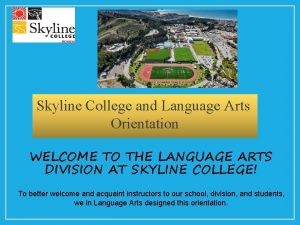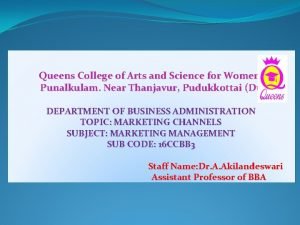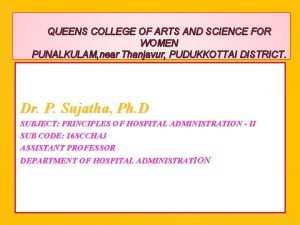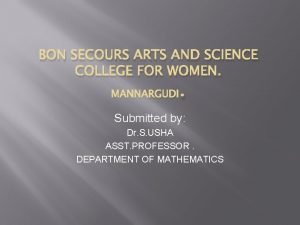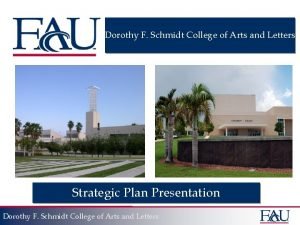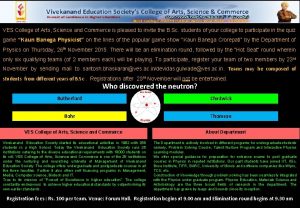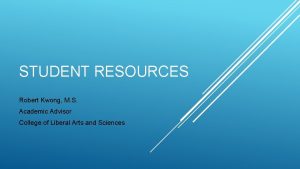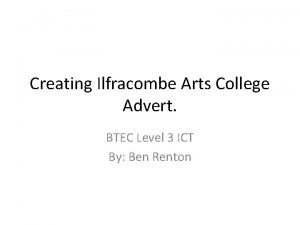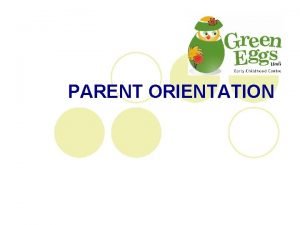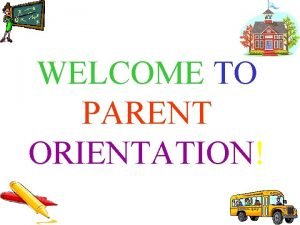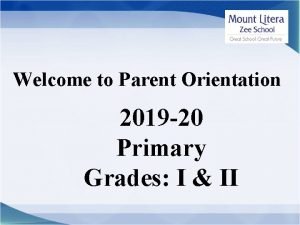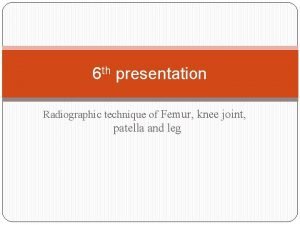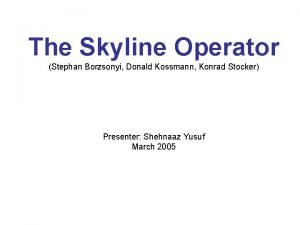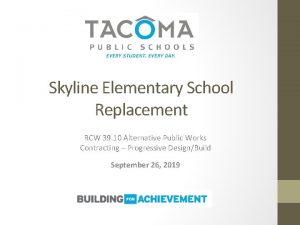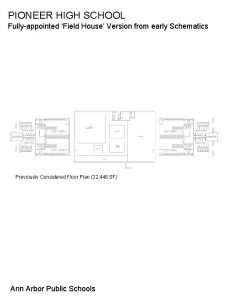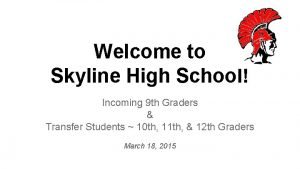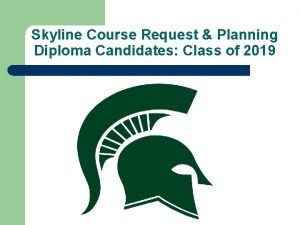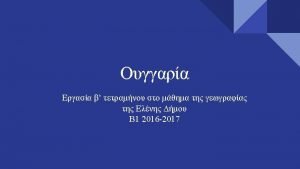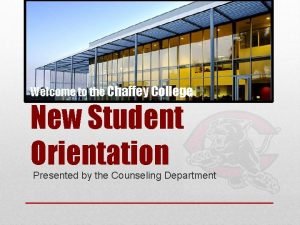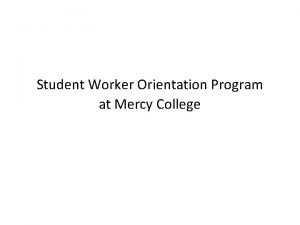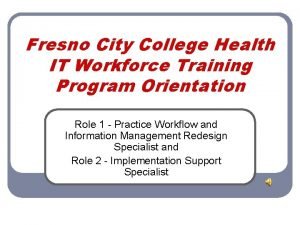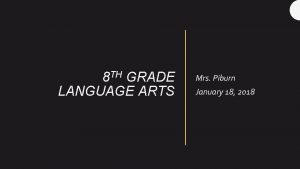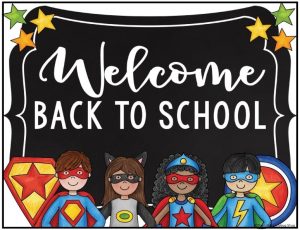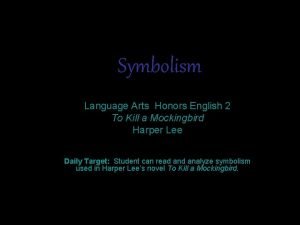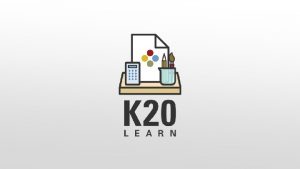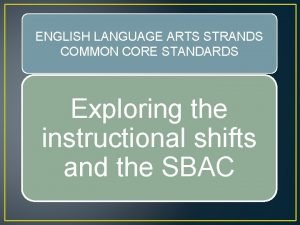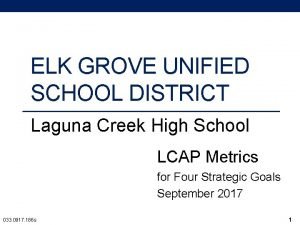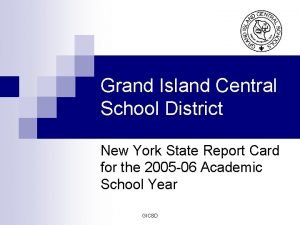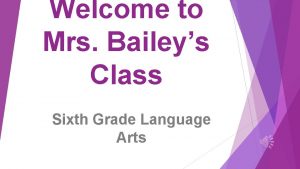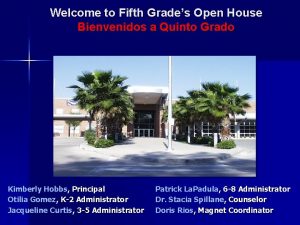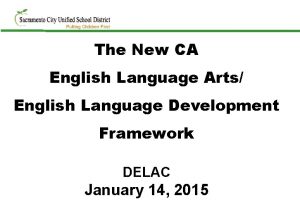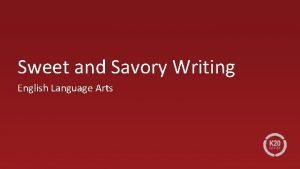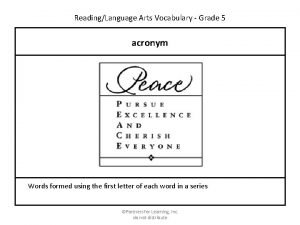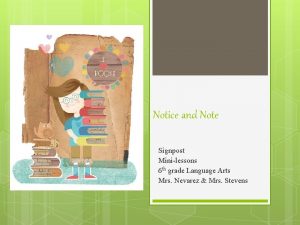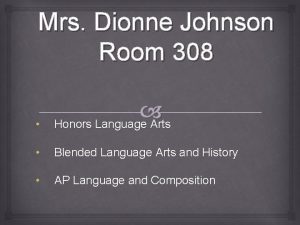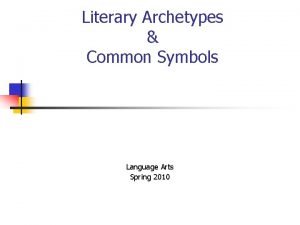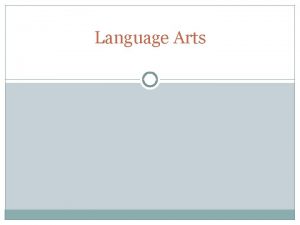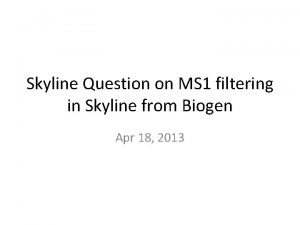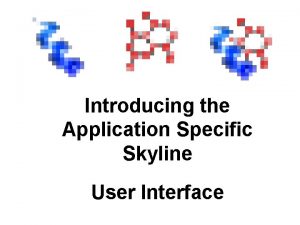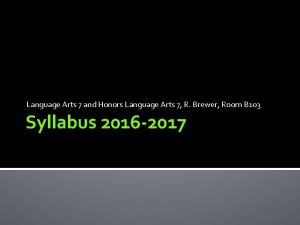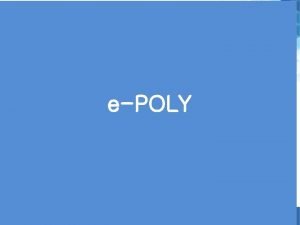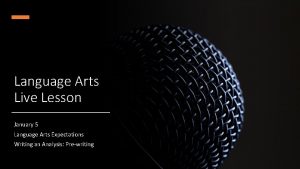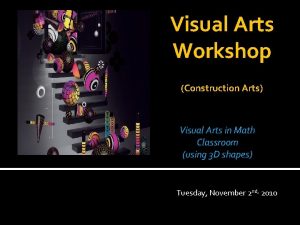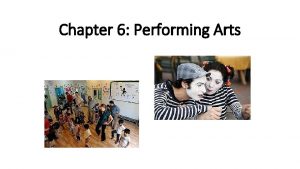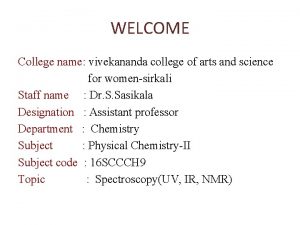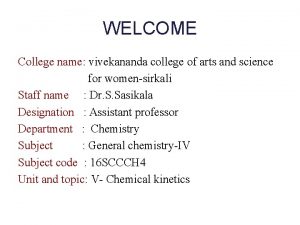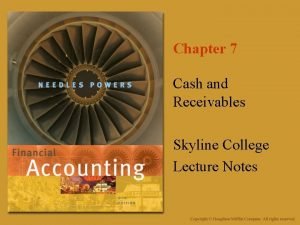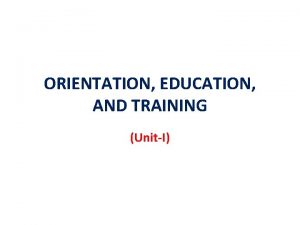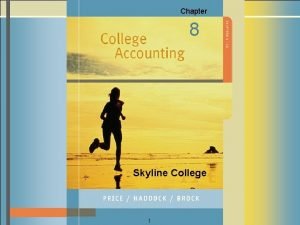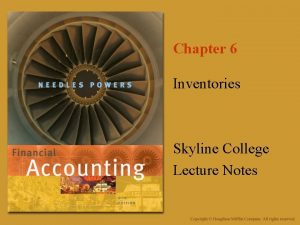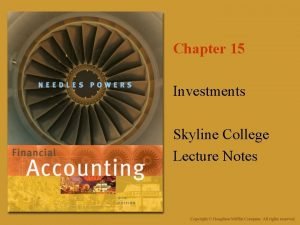Skyline College and Language Arts Orientation WELCOME TO




















































- Slides: 52

Skyline College and Language Arts Orientation WELCOME TO THE LANGUAGE ARTS DIVISION AT SKYLINE COLLEGE! To better welcome and acquaint instructors to our school, division, and students, we in Language Arts designed this orientation.

Skyline College and the Campus Climate Skyline College is one of three community colleges within the San Mateo County Community College District. Opened in 1969, the College is located just south of San Francisco in San Bruno, California on a site overlooking the Pacific Ocean. Vision Statement: Skyline College inspires a global and diverse community of learners to achieve intellectual, cultural, social, economic and personal fulfillment. Values Statement: Education is the foundation of our democratic society. Social Justice: We are committed to a comprehensive diversity framework that promotes social justice throughout all policies, procedures, and practices of the College. Campus Climate: We value a campus-wide climate that reflects a ‘students first philosophy' with mutual respect between all constituencies and appreciation for diversity. Both instruction and student services are dedicated to providing every student with an avenue to success. Open Access: We are committed to the availability of quality educational programs and services for every member of our community regardless of level of preparedness, socio-economic status, gender expression, sexual orientation, cultural, religious, or ethnic background, or disability status. We are committed to providing students with open access to programs and responsive student services both in person and online that enable them to advance steadily toward their goals. Continued…

Skyline College and the Campus Climate Student Success and Equity: We value students’ success in achieving their goals, on-time, and strengthening their voices as they transform their lives through their educational experience. We aim to close gaps that result in inequitable outcomes by ensuring that each student has the opportunity to succeed. Academic Excellence: We value excellence in all aspects of our mission as a comprehensive community college offering preparation for transfer to a baccalaureate institution, workforce and economic development through career technical education programs and certificates, Associate of Arts and Associate of Science degrees, a baccalaureate degree, basic skills development, and lifelong learning. We are committed to academic rigor and quality with relevant, recent, and evolving curricula and wellequipped programs that include new and emerging areas of study. We are dedicated to an educational climate that values creativity, innovation and freedom of intellectual exploration, discovery, thought, and exchange of ideas. Community Connection: We value a deep engagement with the community we serve and our role as an academic and cultural center for community including business, industry, labor, non-profits, government and the arts. We are dedicated to maintaining a college culture and institutional climate that is warm and welcoming to all. Participatory Governance: We value just, fair, inclusive, and well understood, transparent governance processes based upon open and honest communication. Sustainability: We value an institutional culture that represents a strong commitment to environmental sustainability and justice. We are committed to the tenets of sustainability “To meet present needs without compromising the ability of future generations to meet their needs. ”

Skyline College Initiatives Skyline is an active campus with many initiatives to support student success underway. Here are some of those initiatives: The Skyline Promise Get in. Get through. Get out. . . on time!. Skyline College is committed to empowering students to find success at every point in their educational journey. The Skyline College Promise is the College's commitment to help students "Get in. Get through. and Get out. . . on time!" according to their educational goals. The Promise establishes pathways to student success and addresses barriers commonly faced by students through strengthening educational offerings, interventions and support programs. For more information on the Skyline Promise, visit: http: //www. skylinecollege. edu/promise/about. php

Skyline College Initiatives The Skyline Promise Scholarship The Skyline College Promise Scholarship is available to high school graduates and students who recently completed their GED/HSE or Adult Education program and who enroll at Skyline College full-time and plan to earn a certificate or degree. The Scholarship supports the College's Promise to help students "Get in, Get through, and Get out. . . on time!" by making college more affordable and ensuring that higher education is achievable for all members of our community. Recipients receive a waiver covering all enrollment fees for any gap left after applying your financial aid award. For more information on the Skyline Promise Scholarship, visit: http: //www. skylinecollege. edu/promise/

Skyline College Initiatives Meta Majors and Guided Pathways Meta Majors are collections of academic majors that have related courses. Meta Majors cluster groups of degrees & certificates that are considered similar from a student’s perspective. In most cases, students will still declare a major in a specific discipline or department. However, the courses offered in that department will be more likely to be conceptually and structurally connected to related disciplines and areas of study under the same Meta Major. Potential Benefits of Meta Majors: * Students are taking excess units (which costs money and slows them down) and are unclear on requirements to transfer * Students do not have to declare a major immediately and are at less risk of taking unnecessary units * Fewer excess units and less uncertainty about requirements for completion * Planned intentional exploration of careers and opportunities within a general field of study Continued…

Skyline College Initiatives Meta Majors and Guided Pathways are clear roadmaps of coursework that students will need to complete to earn a degree or certificate. This includes both General Education as well as courses within the major. Potential Benefits of Guided Pathways: * Students are taking excess units (which costs money and slows them down) and are unclear on requirements to transfer * Fewer wasted units * Intentional course sequence can lead to better rates of course completion * Students move through coursework with fewer obstacles and a clear understanding of the path Problems with the Current Model: * More than half of students are not meeting their goals – only 49% of students successfully complete within 6 years! * Students are taking excess units (which costs money and slows them down) and are unclear on requirements to transfer * Students may exhaust access to Federal financial aid before or by the time students are able to transfer * “Cafeteria style” general education can seem irrelevant to students, undermining achievement of ISLOs For more information on Meta Majors and Guided Pathways, visit: http: //skylinecollege. edu/metamajors

Skyline College Initiatives College Success Initiative: The mission of the College Success Initiative (CSI) is to develop and implement a comprehensive developmental education program that will facilitate the transition of students into and through degree, certificate, and transfer courses and programs. CSI has initiated and supported many programs and projects to help our students achieve greater success in their basic skills courses. Some of the projects and programs include the Career Advancement Academy, First-Year Experience/Second-Year Experience, Supplemental Instruction, Early Alert, and acceleration in math and English. CSI Definition, Mission & Goals CSI Program Skyline’s College Success Initiative (CSI) is building a pathway through the College that is characterized by a commitment to student learning through access, progress, and success. The CSI began with a focus on basic skills courses (non-degree applicable courses below college-level transfer), programs, and services that contribute to the overall well-being of basic skills students. The focus has since expanded to encompass their needs as they progress beyond basic skills to career technical and transfer level courses. CSI is the culmination of two major initiatives, both of which involved year-long, critical self-study processes: the Foundation of Excellence First Year Experience (FYE) project, and the State Chancellor Office’s Basic Skills Initiative (BSI). Both focused on the need to be intentional about our actions and programming, and the need to integrate instruction and student services to support student success. Continued…

Skyline College Initiatives CSI Definition, Mission & Goals CSI Mission Statement Skyline’s comprehensive CSI Plan will integrate instruction and student services to facilitate the transition of students into, through, and beyond degree, certificate, and transfer courses and programs. CSI Philosophy Statement Skyline is committed to removing academic barriers, enabling smooth academic transitions, creating clearer pathways to student success, and providing student-centered approaches to learning. Overall CSI Goals * Forge a comprehensive CSI Plan that provides clear pathways to student success into, through, and beyond Skyline College. * Prepare all basic skills students to succeed in college level courses and to achieve their educational goals * Create a welcoming and supportive learning environment for students. * Create student support programs and services that promote student growth and development. * Create innovative, approaches to learning based on best practices. * Provide diverse approaches for students with multiple learning styles. * Create contextualized curriculum for students. * Foster faculty and staff collaboration focused on student success. For more information on the College Success Initiative, visit: http: //skylinecollege. edu/collegesuccessinitiative/index. php

Skyline College Support for Innovation Skyline is very supportive of faculty innovation and professional development. Here are some ways to get support for your ideas and professional growth: President's Innovation Fund The President's Innovation Fund (PIF) is an initiative designed to support creativity and innovation at Skyline College. Faculty, Staff and Administrators are encouraged to “Dream Out Loud” and propose ideas that will support the college’s Mission - Vision - Values. The primary provider of the funds is the President’s Council, a group of dedicated community members committed to actively supporting Skyline College. The President’s Council raises financial support for the President's Innovation Fund by hosting the President's Breakfast every spring. The San Mateo County Community College Foundation, whose mission is to promote student success and program innovation, also provides resources to support the President’s Innovation Fund through the generosity of donors. The Board of Directors is made up of dedicated community members who champion development efforts and build meaningful relationships between the colleges and the community in order to advance the mission of San Mateo County Community Colleges Foundation. The experienced staff is committed to helping donors reach their philanthropic goals. For more information on the President’s Innovation Fund (PIF), visit: http: //skylinecollege. edu/presidentsoffice/innovationfund/php

Skyline College Support for Innovation The Center for Transformative Teaching and Learning (CTTL) Building 1, Room 1 -311 G, Phone: 650 -738 -7278 Skyline College’s Center for Transformative Teaching and Learning (CTTL) serves as a hub of innovation and professional development where faculty, staff, and administrators will find resources and opportunities that will help them strengthen student learning, engagement, support, and success. Through the integration of pedagogy, technology, and innovation, the Center provides an environment and tools that support the transformation of teaching and learning needed to empower and transform a global, diverse community of learners. The CTTL includes The Learning Space, where Skyline College employees come to experiment with the latest educational technologies and engage in conversations about teaching and learning, best practices, professional development for Classified staff, and other related topics. For CTTL events and workshops, visit: http: //skylinecollege. edu/cttl/eventsandworkshops. php For more information on the CTTL, visit: http: //skylinecollege. edu/cttl/

Where Things are on Campus Here is a map of Skyline College… The Language Arts Division office is in building 8 in room 8110 -8112 Continued…

Where Things are on Campus Building 1: First Floor: Spark. Point (1 -214) Financial counseling, help getting public assistance, Food Pantry, Career Counseling, and EDD Office all open to the public (not just students) The Dream Center (1 -219) Help for students with AB 540 admissions, DACA, California Dream Act, and other immigration issues English Language Institute (1 -218) Assistance for non-native English speakers enrolling in classes, applying for financial aids, educational planning, support for learning English/getting tutoring, help accessing other student support services on campus Get your photo for your SMCCD ID in Bldg 1 -100. Building 1: Second Floor: Center for Transformative Teaching and Learning (CTTL) (1 -311 G) Offers professional development opportunities for faculty at Skyline. They run weekly workshops. The CTTL can also offer help with Canvas. Building 2: Student Health Services (2 -209) Admissions and Records Transfer Center Psychological Services (2 -206 and 2 -237) Computer Labs (First floor) Testing Services (First floor, 2 -116) (Can sometimes administer make up exams for students) Continued…

Where Things are on Campus Building 4: Offices of the College President and Vice Presidents Accounting and Payroll International Student Office (4 -258) Some of the Learning Community Offices: ASTEP, Puente, CIPHER, and Kababayan Department of Cosmetology (which offers spa and salon services for faculty and staff). Building 5: First Floor: Disability Resource Center: (5 -132) Provides accommodations, counseling and support services for students with documented disabilities. The Learning Center: (5 -100) Tutoring, Supplemental Instruction, Academic Skills Workshops, Retention Specialist. Media Services (5 -115): Fill out an ITS request form to request use of things such a digital video cameras. http: //bookstore. skylinecollege. edu/Site. Text. aspx? id=24186 Photocopy. You can get to Sky. Gap by going through the Learning Center, and back the hall past Media Services. The office is on the right immediately before the exit doors. You can email individual photocopy requests with the document and request form to skygap@smccd. edu. Building 5: Second Floor: Library. If you need to have a library research workshop, put things on reserve, make a purchase recommendation, you can find the forms for that here: http: //www. skylinecollege. edu/library/forfaculty/index. php. Continued…

Where Things are on Campus Building 6: Café & Cafeteria Bookstore Center for Student Life Public Safety Meeting Rooms Parking: It might be useful to keep a map of the campus or a link on your smart phone; if you are teaching mid-morning/mid-day parking gets tight. Hiking Trails: There are hiking trails around campus. The Milagra Ridge Trail and Sweeny Ridge Trail are closest. A map of these trails can be accessed here: http: //www. parksconservancy. org/map/#/visit/park-sites/sweeney-ridge. html? coords=15: 37. 6221: 122. 4667. Once a month, there is a walking group that does a hike or walk around the campus area. The District Human Resources Office is at CSM; 3401 CSM Drive, San Mateo, CA

Our Students at Skyline College To best teach our student population, here is some helpful information about our students: General Information: - 59% of our students experience college for the first time at Skyline College. - 71% of our students’ primary goal is to transfer to a four-year institution. - 40. 9% of our students’ primary goal is to obtain an associate’s degree and 46% of these students anticipate completion within 2 years. - From 2003 -04 to 2012 -13, 3487 students transferred to the CSU system (primarily San Francisco, San Jose, and Hayward/East Bay). 836 students transferred to the UC system (primarily Berkeley and Davis). 778 AA/AS Degrees were awarded during that time period as well. - Approximately 72% are fulltime students and 28% are part-time. - 40% of students attend classes during the day and 35% of students attend evening classes. - The three most popular majors are Interdisciplinary Studies, Business and Health. - The majority of our students are from San Francisco, Daly City/Colma, and South San Francisco. 51% of the population of Daly City is foreign born. 43% of South San Francisco is foreign born. Continued….

Our Students at Skyline College Types of Pressures and Time Restraints They are Under: - 80% of the respondents from the survey are employed - 52% take care of dependents - 26% of respondents cite grants & scholarships as a major source of funding - 49. 1% rely on their own income and savings as a major source to pay for college - 36. 7% rely on their parents or significant other as a major source to pay for college Skyline serves North San Mateo County, regularly sited as one of the most expensive counties in CA. Demographics:

Student Support Services Disability Resource Center (DRC): Location: 5 -132, Phone: 650 -738 -4280, Email: skydrc@smccd. edu Provides accommodations, counseling and support services for students with documented disabilities. DRC students should present you a letter of accommodation so you can provide accommodations (i. e. extended time on tests, a quiet environment to take exams, etc). Look at each letter to see what accommodations need to be made. If you have any questions, contact the DRC. If the student fills out the online request, he/she then needs to forward that request to you, so you know to fill out the online form. For more information, visit: http: //skylinecollege. edu/disabilityresources/ Financial Aid: Location: 2 -234, Phone: 650 -738 -4236, Email: skyfaoffice@smccd. edu Skyline College offers access to many resources, including fee waivers, grants, scholarships, work study programs and loans that are geared towards making college affordable. Academic Counseling: Location: 2 -218, Phone: 650 -738 -4318 Skyline College’s academic counselors provide guidance and information to empower students to succeed and meet their educational goals. Students can meet with a counselor to develop a plan of action. Counselors also work in collaboration with the staff of the Career Center and Transfer Center and other student services to support student success. For more information, visit: http: //www. skylinecollege. edu/counseling/ Continued…

Student Support Services Health Services: Location: 2 -209, Phone: 650 -738 -4270, Email: skyhealth@smccd. edu The Health Center provides health care and mental health services, referrals, and health educational information to students. All Health Center Services are done on a drop-in basis, except an appointment is needed for Program, Transfer, or Employment health screenings. Please call or stop by the Health Center to schedule an appointment. For more information, visit: http: //www. skylinecollege. edu/healthcenter/ Psychological Services: Location: 2 -206 & 2 -237, Phone: 650 -738 -4270, Email: skyhealth@smccd. edu Psychological Services offers brief confidential individual counseling, crisis intervention, mental health and substance abuse assessments, and community referrals. The goal of counseling is to support students in identifying and managing personal concerns, learn more about themselves and make positive life changes. Talking about issues and concerns in a safe and confidential environment can enable students to become more successful in college and life. For more information, visit: http: //www. skylinecollege. edu/healthcenter/psychologicalservices. php Library: Location: Bldg 5, 2 nd floor, Phone: 650 -738 -4311, Email: skylibrary@smccd. edu Visit: http: //www. skylinecollege. edu/library/ Bookstore: Location: 6 -101, Phone: 650 -738 -4211, Email: skylinebookstore@smccd. edu For store hours: http: //bookstore. skylinecollege. edu/Store. Hours. aspx For more information, visit: http: //bookstore. skylinecollege. edu/home. aspx Public Safety: Location: 6 -106, Phone: 650 -738 -4199 Subscribe to Alert. U: Alert. U enables college administration to send emergency information by text messages to cell phones on a subscription basis. To sign-up, go to: http: //www. smccd. edu/alertu/ For more information on Public Safety, visit: http: //www. skylinecollege. edu/publicsafety/ Continued…

Student Support Services Spark. Point: Location: 1 -214, Phone: 650 -738 -7305 Spark. Point features the following for students and faculty: For more information, visit: http: //www. skylinecollege. edu/sparkpoint/ Continued…

Student Support Services Veterans Resource Center: Location: 2 -350, Phone: 650 -738 -7060, Email: skyveterans@smccd. edu We are committed to helping students make the best possible choices while attaining the maximum assistance, guidance, and support while pursuing their educational goals. Skyline College assures its veteran students receive superb support services, and resources for personal growth and development, and educational success. Skyline College is a participant in the VA Principles of Excellence. For more information, visit: http: //www. skylinecollege. edu/veterans/ The Learning Center: Location: 5 -100, Phone: 650 -738 -4144 http: //www. skylinecollege. edu/learningcenter/ Writing & Reading http: //www. skylinecollege. edu/learningcenter/writingreadinglab. php ESOL http: //www. skylinecollege. edu/learningcenter/esollab. php Math http: //www. skylinecollege. edu/learningcenter/mathlab. php Science & Social Science http: //www. skylinecollege. edu/learningcenter/sciencelab. php

The Language Arts Division Office and Workroom in 8110 -8112: - Office location of Dean, Division Assistant and Program Services Coordinator - Faculty mailboxes in 8110. If you teach only at night, your mailbox will be in 2226. - For instructor use: 2 PC computers, 1 Mac computer, a printer, a FAX machine, a paper cutter, staplers. Ask the Division Assistant for other supplies. To log into the Workroom computers, enter your user name (the part before @smccd. edu) and your SMCCD email password. - Tables for faculty to work at and/or meet with students - Also for faculty use: refrigerator, coffee pot, microwave, sink - Copy machine: copies are limited to 300 per class (copy code is the last 5 -digits of your G-number). However, we’re discouraged from making copies on this machine; it’s unreliable and more costly. It’s better to submit copy orders to Graphic Arts & Production (there’s a 2 -working day turn-around). Complete a SKYGAP copy request form and give it to the Division Assistant or email it along with what you want copied to: skygap@smccd. edu Continued…

The Language Arts Division Instructor Attendance: Notification of Absence(s): If you will be absent from a class, email your students and inform them of any work you want done in the meantime. If you teach day classes, also inform the Division Office at (650) 738 -4202. Saturday and evening instructors should contact the evening office assistant at (650) 738 -4206. When you call, identify the class level, the time, the classroom and any assignment you want completed before the next class meeting so that a notice can be posted. Important: the “class cancelled” notice is an official format used at Skyline College. Please do not post absence notices other than the one used by the College. If you plan to be absent more than a session or two, please speak with the dean to jointly ascertain if a substitute should be called in. An Absence Affidavit will be placed in your mailbox soon after. Jury Duty: Day instructors who are called to jury service during normal work time will be paid by the District. While you are on jury duty, please sign the payment waiver designed for state employees.

Departments in the Language Arts Division English and Literature: The English Program at Skyline College provides students with the skills they need to read, write and think critically and express their ideas clearly, creatively and persuasively. We offer an Associate of Arts degree in English that can help to create a clear path for transfer to a four-year institution. Skyline College also offers Literature courses for students looking to deepen their understanding of literary traditions and their relevant contexts. Literature students will expand their knowledge of literary texts by exploring the motivations and creative processes of a variety of English-language writers. English for Speakers of Other Languages (ESOL): English for Speakers of Other Languages (ESOL) classes are designed for students who want to improve their written and spoken English skills. The ESOL department provides: - five levels of ESOL instruction from Adult Ed into College ESOL - evening and weekend classes - classes in vocational ESOL - dedicated ESOL counseling at the English Language Institute - access to the PACE Learning Community Communication Studies: Students enrolled in the Communication Studies Program at Skyline College can expect to become proficient in multiple areas of communication, including public speaking, interpersonal communication, small group communication, intercultural communication, and argumentation and debate. Skyline College offers one Associate Degree and two Associate Degrees for Transfer in Communications that provide a clear path for transfer to a four-year educational institution. Continued…

Departments in the Language Arts Division World Languages: Skyline College’s World Languages Program offers a variety of languages that serve our constantly changing Bay Area community and our students. Language courses offer a unique opportunity for students to challenge themselves to expand their worlds and enrich their lives. Students can choose courses from the following languages: Associate of Arts Degree: Spanish Individual Courses: Filipino, Chinese, Arabic, and American Sign Language Journalism: Skyline College’s Journalism Program is both an academic and career technical program that prepares students to enter the workforce in journalism and related fields. We offer both an Associate of Arts degree which can help to create a clear path for transfer to a four-year institution and a certificate of achievement which provides a head start on the road to employment. Students participating in the Journalism program also produce The Skyline View, Skyline College’s studentrun newspaper, providing hands-on experience with print-production, journalistic writing, editing, and various forms of online media.

Learning Communities in the Language Arts Division There are several Learning Communities (LC) connected with courses in Language Arts that allow students to enroll in a preset group of classes with other students who share the same passions, interests, or specific field of study. Students take classes together (between 1 -3 semesters) and work closely with specific faculty and counselors assigned to their learning community and invested in student success. Continued…

Learning Communities in the Language Arts Division

Getting Started Checklist Phone and Email: All faculty must have a San Mateo Community College District phone number and email to receive messages from both students and the district. To register for both, see the dean or division assistant. Quick note: all Skyline phone numbers start with 650 -738 + the four-digit extension of the person you are trying to reach. If you are calling on campus, use only the extension number. Keys: For room keys to the Division Workroom, etc. , see Division Assistant. Parking Permit: To get a parking permit, request and complete the form from the Division Office. The Division Assistant will process your parking permit and place it in your mail box. Be sure your parking permit is visible in your car as parking enforcement is not very forgiving. To contest a parking citation, visit: https: //www. pticket. com/. Door Card: All faculty must post online door cards listing their class times and office hours. In accordance with the AFT contract, full-time faculty must be present a minimum of two hours each required service day. Adjunct faculty must meet with students 1 hour per week per every 3 -unit class. Adjuncts may meet students in the Division Workroom in 8110 -12 or another available oncampus meeting space such as the library. To create a Door Card, go to the District Portal page: http: //www. smccd. edu/accounts/portal/ and in the search box type “door cards. ” Also, through the Portal, you can log into your smccd email, find contact information for any district employee, and if you have technology or facilities issues, you can create and submit work orders. Many of the school/district materials can also be accessed through the Portal, so it’s a good site to bookmark. Smart Classrooms: Acquaint yourself with your classroom(s). All our classrooms are equipped with document readers and hook ups for laptops which allow you to project material onto the larger screen with sound, visuals, and internet connectivity. Macs require adaptive connectors. Call Media Services at x 4142 for issues regarding smart classroom equipment. Continued….

Getting Started Checklist Websmart: Log into Websmart https: //websmart. smccd. edu/ to download your class lists, attendance forms, grade sheets, and add codes. You can also send class or individual emails. You will also use Websmart to drop/withdraw students who are not attending class and to enter all your final grades. See the Division Assistant for your username and password. Canvas: A course shell will automatically be created for each class in our online classroom platform Canvas. For online classes, all instruction will take place in Canvas. For non-online classes, you may choose to use Canvas for: discussion forums, posting readings/class materials, quizzes, group projects. See the dean for Canvas training but there also online tutorials for instructors. To log into Canvas, go to https: //smccd. instructure. com/ and for your username, enter what comes before your @smccd. edu email address and the password is the same as your smccd email password. Also, ask the Division Assistant to send you an invite to join the online Language Arts Canvas space where you can post division announcements, post/share teaching materials, access meeting notes, and build department/program/project spaces to fit your needs. Reserving Computer Labs: Contact the Division Assistant to reserve space in the Language Lab in the Learning Center (Bldg 5). If the Language Lab is not available, contact Ryan Samn (samnr@smccd. edu) with Academic Support and Learning Technologies in the library for other labs (normally building 2). If neither the Language Lab or other labs are available, contact Teresita Del Castillo-Brown (delcastillobrown@smccd. edu), with Business/Computer Systems to see if you can reserve space in the Accounting Lab in 8121.

Shared Division-Wide Best Teaching Practices: RETENTION: Email: Even in non-online courses, sending emails that contain helpful reminders, check-ins, changes, will help retain your students. You can start with a “welcome” email before classes start, send reminder emails before major assignments are due, and check in with students who have missed several classes. Use an encouraging and understanding tone rather than a strict, chastising tone that may alienate students. Offer support for students who have fallen behind. Support Services: Connect struggling students to support services right away. There a lot of Academic, financial, mental health, learning disabilities support on campus so know how to quickly connect students to what they need to be successful. See the Support Services section for more information. Affective Domain: Affective domain asks instructors to be mindful of students struggling in classes. When students aren’t successful in classes, the core issue is not always that they can’t handle the course content; instead many are intimidated by the tasks required. Attending the affective domain means: 1) establishing and maintaining positive teacher/student relationships, 2) providing class time for students to process content and practice skills, 3) creating regular opportunities for students’ metacognitive reflection, 4) offering incentives and insisting on accountability for coming to class and doing the work, 5) intervening when students show signs of struggle or disengagement, 6) maintaining a growth mindset where students are encouraged to think of the big picture regarding their growth, and not just the assignment at hand. Dropping/Withdrawing Students: Avoid dropping or withdrawing any student without first trying to contact him/her through email/phone on multiple occasions. Please consider that some students could lose their financial aid and in the case of International Students, if you drop them, they can lose residency status. Contact Mylene Foo ( foom@smccd. edu) at the ELI or Chikako Walker (walkerchikako@smccd. edu) at the International Student Office if you are in doubt about if a student is an international student.

Shared Division-Wide Best Teaching Practices: FIRST DAY OF CLASS ACTIVITIES: Syllabus/Class Policies: Read over the syllabus in detail. Some students may be first-generation and first-semester and need help understanding what college entails or how it differs from high school (what are college expectations: expected reading totals per week, email etiquette, classroom behavior, etc. , how to respond to serious content material, etc. ). Office Hours Explanation: Explain what office hours are and how current research links office-hour visits to higher grades. The advantages include: better relationships with professors, with the latter more likely to take on active mentoring roles for students who attend; more confidence in work; advocating for self; higher likelihood of completing a degree, especially for students from underrepresented groups; development of important skills for college and the workplace, such as planning, long-term thinking, and self-efficacy. Establishing Community: Lead with activities that help students get to know you and each other to create an inclusive environment from the beginning. First day activities could include: • Lead off with activities that help you and the students learn one another’s names. • Have a class discussion on how to create a good, respectful discussion. • Have students introduce themselves either in pairs or small groups (since they can be nervous on the first day) and ask them to tell the group a little bit about themselves or the classmate(s) they just met. If the class is online, you can assign a getting-to-know-you type of activity. • Send students on a campus tour in small groups or pairs. Have them bring back fliers/an artifact from the Learning Center, Sparkpoint, the Theater/Art gallery, Admissions, the Library, etc. Have students ask questions of staff members and introduce themselves; answer various questions on a questionnaire as they go. You can send the groups in different directions at the beginning, so they don't rush anyone's office all at the same time.

SYLLABI: Shared Division-Wide Best Teaching Practices: Use the Division Syllabus Template created by faculty: Use the Language Arts Division Syllabus Template which our faculty in Language Arts created together. Tone/Language in Syllabi: Think about using compassionate, inviting, encouraging language and avoid rigid alienating tones. Try to avoid imperatives: shoulds, must; use can, could. Tell students what they can do in the space you’re creating with the course. Make theme of your syllabus one of invitation. Talk about possibilities rather than prohibitions. Allow students to see what they can get out of the course, not why they have to. Communicating with Students: Make it easy and welcoming for students to contact you with questions, concerns and give them multiple methods to do so (i. e. email, office phone, chat). Student Learning Outcomes/Official Course Outlines: Remember to include the SLOs for the course in the syllabus. The purpose of SLOS is to ensure all instructors are teaching the material appropriate to the level. SLOs are also used in our accreditation process where we look at ways to improve our teaching. Please consult the official course outline on Curricunet (go to: http: //www. curricunet. com/smcccd/ and under “search” select “Course” and then select your course). Design your syllabus to meet all the standards and requirements for the course. Teaching Philosophy: Give your teaching philosophy in your syllabus: explain your approach to the course as a whole. Is it based on student -led discussion, the Socratic Method, problem-based learning? Sharing your teaching approach with students helps them see who we are as Skyline instructors, and gives them insight into the type of environment we’re hoping to create in the classroom; it also makes students aware of our expectations and their opportunities for engaging with us, each other, and the course material. Calendar/Schedule: Provide a specific calendar of topics and assignments. Show students when things are coming, and how course components fit together. Organize the semester, not just with dates but with general topics, specific issues, and guiding questions. Students should be able to look at the calendar and not only know what’s due for a particular day, but where that class session fits in the larger framework of the course.

Shared Division-Wide Best Teaching Practices: STUDENTS FIRST: Texts: When possible, choose relevant texts that reflect the lives, background and social issues that would interest our students. Student Engagement: Create interactive activities that engage active learning. Avoid classes that are all lecture and instead balance in group work and student-led activities. Facilitate student conversation by validating student contributions, asking following up questions, asking students to respond to one another, and promote student-led discussions, presentations, and projects. Student-Led Course Design: Other ways to have the student lead, is allowing them to construct the rules for productive class discussion in the course and/or lead students in constructing/editing parts of the syllabus. You could project the syllabus as a word document on the board that you edit together as a class. You can decide together issues such as should cell phones ever be used in class? Should there be a penalty for being late? Are there additional course objectives and outcomes student would like to set? You could also allow students to select certain course texts. Feedback: Provide timely and clear feedback on work. Check-in with students and get their feedback on your feedback (i. e. was it clear, can they summarize it in their own words, are there areas of instruction they would like revisited), construct ways for students to give each other feedback, create opportunities for self-assessment. Also, check in with other faculty in your department on effective feedback approaches, and use department rubrics/grading standards/best practices.

English Department Philosophy: We support the college mission to foster a global community of learners and encourage and develop lifelong learners. We infuse our curriculum with multiple cultural and political perspectives, enabling our students to gain new social awareness through considering views from different cultural, ethnic, sex/gender, sexual orientation, socio-economic, political, and religious backgrounds. We believe in creating student-centered classrooms through fostering collaboration, project-based learning, technology integration, and thoughtful conversations between students and teachers about learning. We believe in the affective domain, a pedagogical tool for instructors to better ensure student success by identifying, understanding, and addressing how our students learn. We encourage text and topic assignments centered on theme of social justice and equity with the goal of developing a strong sense of social responsibility and leadership in our students. In addition, at every level, we assign text-based writing, so student learn in actively engage with and critically respond to the writing, thoughts and arguments of others. Program Learning Outcomes (PSLOs): Upon completion of the program, students will be able to… A. ESSAYS: Write focused, organized, well-developed, and text-based essays using effective paragraphs, which support a clear thesis statement, and demonstrate competence in standard English grammar and usage. B. CRITICAL ANALYSIS: Demonstrate critical reading, writing, and thinking skills through analysis, synthesis, and evaluation of important ideas. C. SOURCES: Effectively evaluate and fluidly integrate relevant sources, using appropriate research strategies and tools, and documenting them according to MLA guidelines. Continued…

English Department Best Practices: . IN-CLASS: Agenda: Write a road map on the board every day. What activities will happen in class? What outcomes are expected? How does this day fit within the larger context of the course? How are this day’s lessons/activities connected to the next paper/project that is due? Modeling: Model how to perform a new or challenging task or skill. Let the students watch you model or demonstrate steps in the task or activity. For example, project a text using the document camera and annotate it in front of them; model peer review by reviewing an essay as a class; model an arguable claim on the board to show a claim that is not arguable and change it to one that is. Text Based Writing Assignments: Writing assignments in English classes must be text-based; in other words, essays are based on analyzing the readings. These requirements are part of the transfer mandate set by UC Berkeley. The ENGL 828 and ENGL 846 course outlines require the study of one book length non-fiction text. The ENGL 100/165 course outline requires the study of two non-fiction book length texts. The ENGL 110 course outline requires the study 4 genres: poetry, short stories, plays, and a novel. Reading Strategies: Pre-transfer classes require instruction of reading strategies. These include: previewing, predicting, generating questions, activating schema, determining purpose for reading, annotating, monitoring comprehension, reviewing and summarizing, and reflecting. Chapter 1 of the Rhetoric is devoted to Critical Reading strategies, models and practice: http: //www. skylinecollege. edu/skyenglish/1 Critical. Reading. htm Continued…

English Department Best Practices: . IN-CLASS: Teaching Writing as a Process: The writing process includes prewriting, organizing, drafting and revising. Diagramming the composing process for students, and demonstrating this process with actual texts, helps students to become more comfortable with their own writing. Assure students that no writers, no matter how experienced, produce the “perfect” text in one try. The best writing is rewriting, so build multiple drafts into the essay writing process. Chapter 4 of the Rhetoric is devoted to walking through building a paper in stages: http: //www. skylinecollege. edu/skyenglish/4 Writing. Process. htm Creating & Breaking Down Assignments/Prompts: Create prompts that (1) are concise, focused and clear are not wordy, multiple pages, contradictory, or steeped in academic jargon; (2) engage/interest students, are connected to topics that are current/relevant, and that use inviting language; (3) that progress over the semester towards more autonomy, freedom, and agency; (4) that have clear context, purpose, audience, and connect to the reading; (5) that are connected to clear expectations, learning outcomes, and make the evaluation criteria clear. Also, test your prompts to make sure you could write a good thesis/outline/draft; test prompts by getting feedback from colleagues; help students to best understand prompts: break down/annotate prompts in class; rephrase prompts in the students’ own words; and consider involving students in the crafting/revising of prompts. Use the advice and practice in the Rhetoric on breaking down prompts/assignments: http: //www. skylinecollege. edu/skyenglish/3 Papertopics. htm Review: Ask students to review: what did we learn last time? Let students lead the review. Spend a few minutes at the beginning of class reviewing what happened in the previous session. Continued…

English Department Best Practices: IN-CLASS: . Peer Editing: Provide students with a real audience they care about: their peers. Give them structured opportunities to provide feedback at various stages in their writing: brainstorms, outlines and especially drafts. Consider adding point values to peer review to encourage thorough and thoughtful peer feedback. Have students use the same grading rubric that you use when responding to their papers, so their writing goals and expectations are clear. Use the English Department rubrics: http: //www. skylinecollege. edu/skyenglish/6 Rubrics. htm Timed writing: For most of the core English classes, 15 -20% of the graded writing should be timed writing. Timed writing requires students to think on their feet within a limited time-period. Timed writing measures thinking and writing under pressure, a future program and job requirement. Consider assigning shorter “low-stakes” in-class timed writing as well as longer “high-stakes” papers such as the midterm and final exam. Chapter 11 in the Rhetoric focuses on effective strategies and approaches for timed writing: http: //www. skylinecollege. edu/skyenglish/11 Timed. Writing. htm Non-Native Speakers in your Class: If you have ESOL or non-native English speaking students in your class who are struggling, refer them to the ELI for help with anything from emotional issues, visa problems, and extra support in their classes. Mylene Foo can help them out (foom@smccd. edu, 650 -738 -7167, 2 -317). There are grammar tutorials for students, specifically targeting ESOL students, in the Learning Center, and there are tutors who work specifically with non-native English speaking students in the Learning Center. While we have ESOL classes, the ESOL students once they are in “mainstream classes” will still present issues with English and will still need extra support. Depending on the individual, it can take 5 -10 years of intensive study and use of a language to really master another language. For International students, consult with Chikako Walker (walkerchikako@smccd. edu) at the International Student Center prior to dropping international students as they will lose their visa if they are under a certain number of units.

English Department Best Practices: PROVIDING STUDENT FEEDBACK: . Conferencing: Make yourself available to students through a variety of methods (in person, phone, email, video-chat). When conferencing, ask more than tell, don’t “take over” papers and instead have students write down suggestions for revision and have them read their own papers aloud. Often start with focusing on and breaking down the prompt/assignment, then thesis focus, reverse outline. Have a student leave a conference with clear steps for revision (often not more than 2 -4 tasks to focus on). Tone: Be aware of tone. Let students know the tone is always positive. Do this by reading your feedback on a past paper in front of the whole class (use a projector to project the paper and feedback). This allows students to hear the tone of the feedback as encouraging and confidence building. Positive Feedback: Find something positive to say and build from there. This is a strong draft in which you… I was interested to read… Let students know when and what they are doing well, and how they can extend those successes. For instance: This analysis does the kind of close reading we’ve discussed in class. Can you extend this into your other paragraphs? Asking Questions Rather than “Telling”: Keep the comments rhetorical (as a question) and open ended in tone: how do you intend us to understand this concept here… This causes me to question…wow, this really surprised me…Can you say more here…Is your sentence too similar to the critic’s…does it need to be a quotation or treated as a paraphrase with a citation? Continued…

English Department Best Practices: PROVIDING STUDENT FEEDBACK: . Grammar: In grading, marking every single error on the paper is not productive, as it uses a lot of instructor time and is often overwhelming for the student. Instead, identify patters of error: do they have repeated runon sentences, fragments, subject-verb agreement issues? Point out patterns and then guide them on how to address that particular grammar issue, and then have them correct that issue themselves in the paper. Chapter 14 in the Rhetoric is devoted to grammar instruction: http: //www. skylinecollege. edu/skyenglish/14 Grammar. htm. There are explanations with practice exercises on: adjectives and adverbs, appositives, articles, commas, contractions, coordinators, dangling modifiers, fragments, possessives, run-together sentences, subject & verb identification, subject-verb agreement, subordinators, and verb tenses. . . Clear and Concise: Try to categorize and limit your comments. What general areas should the student focus on and why? Marking every error or filling a margin with writing can simply overwhelm. Try to make clear and concise steps for revision. Provide Timely Feedback: For shorter assignments, provide feedback within a week and for longer essays within two weeks, so that students can connect the comments directly to what they wrote while it is fresh. . . Department Rubrics and Grading Standards: To promote consistency and clarity, use the rubrics and grading standards the English teachers at Skyline created together: . . Grading Rubrics: http: //www. skylinecollege. edu/skyenglish/6 Rubrics. htm Grading Standards: http: //www. skylinecollege. edu/skyenglish/6 Evaluating. Writing. htm Students Responding to Instructor Feedback: http: //www. skylinecollege. edu/skyenglish/6 Respondingto. Instructor. htm

English Department Rhetoric—FREE online: The English teachers and other faculty volunteered their time over two years to create this comprehensive and free textbook for students and instructors. We used a consistent structure throughout the textbook to make it easy to learn a concept, to understand its relevance, and then to apply it. That structure is reflected in the textbook title: What, Why, and How? http: //w ww. skylinecollege. edu/skyengl ish/

ESOL Department Philosophy: The ESOL Department is a watershed department that provides language proficiency to nonnative speakers. Our mission is to “develop English language competence in speakers of other languages to support academic college study, pursuit of vocational certificates, enhancement of career options, and increase in civic engagement. ” The ESOL department serves on average about 400 students per semester. However, this number does not represent the total number of non-native speakers on campus; there are far greater numbers of non-native speakers on campus: students, faculty, and staff. Program Learning Outcomes (PSLOs): . . Upon completion of the program, students will be able to…. . A. Comprehend, analyze, synthesize, and discuss English texts for the purpose of furthering academic, personal, vocational and civic growth. B. Critically evaluate and modify own written language to enhance academic, personal, vocational, and civic communication. C. Listen effectively and consistently produce comprehensible spoken English in a variety of academic, personal, vocational and civic situations. ” Continued…

ESOL Best Practices: Grading: For ESOL 830, 840, and 400 it is important to state on the syllabus: “You must get an average of a 70 or better on the midterm and final in order to pass the course. ” Skyline does not have A+ or C-. Diagnostic Tests Needed: The placement test that we had been using was phased out before we had a good replacement. As a result, there might be students in your class who are too low or too high. It will be imperative that in the first week-week and a half of class, that you do a diagnostic test to assess their level. This is going to be difficult for you to know what is at level or not as it’s your first time here; we recommend talking to other ESOL instructors about diagnostics. Marking Student Work: Do not kill yourself giving feedback. Generally, it is best not to correct student writing/work for the students. Mark if there is an error, but do not correct it for them. For level 2, 3, and 4 classes, focus on a few target errors such as those grammar points you’ve worked on in class. Consider allowing students to revise their work. We recommend norming your essays and essay feedback with another instructor who has taught the class before; a good time to do this is during the first essay cycle. Tutoring: The ESOL tutors at the Learning Center can better help your students if they know what your essay prompts are. You can send these to Christina Trujillo and/or Chanel Daniels (danielsc@smccd. edu) at the Learning Center. Continued…

ESOL Best Practices: Holistic Testing for ESOL 820, 830, 840, and 400: In the last week before finals, all ESOL reading and writing classes give a written in-class essay exam to students. This exam is created towards the end of the semester collectively, and it is graded collectively. You will get emails about the holistic dates before the semester begins and again towards the end of the semester. Final Exams: You as the instructor are required to come on finals day. You may not cancel this session. However, you may: 1) Give a final; 2) Make the final optional (Ex. if students have 3 absences or less they are excused from the final); 3) Give a short final and then have a party; 4) Have a party or show a movie; 5) Have students come and work on a revision assignment or turn in a revision assignment. Computer Literacy: Different students have varying levels of computer proficiency. It is very possible that your students will not check their smccd student email and/or not know how to check their student email. They may not know how to get onto Canvas. Build up to tech assignments. In other words, take the students to the lab and get on Canvas with them. Model and provide time for students to explore the tech in class. You will need to tell the students to bring their passwords and account info to class when you go to a lab; they often do not have their username and/or passwords memorized. Contact Christina Trujillo (trujilloc@smccd. edu) if you would like to have the Learning Center run a computer literacy workshop. Continued…

ESOL Best Practices: Help for Struggling Students: If students are struggling in your class, email Mylene Foo. Struggling means the student often comes unprepared for class, struggles on assignments, is having personal problems, legal issues, child care problems, work issues, housing problems, and more. Mylene will frequently ask you or student leaders in your class to make announcements pertaining to student counseling, financial aid, and community building activities. Raymon Gutierrez can help pretransfer level students (ESOL levels 2 -4) with academic issues; however, it is easiest to email Mylene and she can refer the student to the necessary student services, be it Raymon at the Learning Center, the Dream Center, counseling, the International Office, or the like. PACE: We have a ESOL student learning community; the idea is that students form a tight community and help keep each other in class not only within one semester, but across their academic career at the college. Students can take ESOL 840 & 854 linked, ESOL 400 & 875 linked, ENGL 105 and COMM 110 linked, and ENGL 110 and HIST 235 together. Students with Disabilities: It is highly likely that you will have students in your classes with disabilities, with and without documentation. ESOL students with documented disabilities will need you to help them remember to make testing arrangements (do not do this for them, but remind them a week ahead of time to make the reservation and communicate with you about it). If you want help talking to a student about a possible disability, talk to the DRC, Mylene, Raymon, the dean, or other ESOL faculty. Continued…

ESOL Best Practices: Kids in Class: Students might bring kids to class. As a department, we are generally flexible about this, but students need to give you notice, give their children something to do, and make sure their kids are quiet and respectful. Consider what you are comfortable with in your class and make the students aware of your policy. Plagiarism: Work with students in class on what plagiarism is in very explicit terms. If after having this discussion, a student continually plagiarizes, consult with the dean. We do occasionally need to report students for repeated or egregious cases of plagiarism. SLOs: We assesses different SLOs on different cycles. For example, one semester, we might assess the Reading and Writing SLOs and another semester we might assess the SLOs for Listening and Speaking. Please pay attention to ESOL Departmental emails to see if you are teaching a class which is in an active assessment cycle. You will use a pre-existing assignment and report how the students faired with a short reflection to the department. Again, you will get info on this during the semester on an as needed basis.

Communication Studies Department Philosophy: The Communication Studies faculty are committed to creating an active and engaging learning environment for students. Whether it is Public Speaking, Gender Communication or one of the other five core courses taught each semester, the faculty intentionally utilize group work, hands-on and kinesthetic activities to maintain high levels of student success and retention. In the Associate of Arts Transfer degree in Communication Studies, we empower our students to find and refine their voices and effectively use communication theories and strategies to increase their cultural awareness, strengthen their relationships, and successfully prepare them for an ever-evolving workforce. Most importantly, we work together as a department to create civically engaged students who use their voices to advocate for those who are unable to advocate for themselves. Program Learning Outcomes (PSLOs): . . …. Upon completion of the program, students will be able to…. . - Effective Communication: Deliver a message using strategies that adapt appropriately to the purpose of a situation; including the specific audience and cultural & psychological climate. …. - Effective Communication: Describe the effects of communication, including listening skills, on the perception of human relationships in social & cultural contexts. …. - Critical Thinking: Demonstrate effective problem-solving communication that leads to successful conflict management by researching verifiable information that supports logically organized main points and claims in a message. …. - Citizenship: Communicate ethical core values and individual cultural identity in a variety of academic, personal, vocational and civic situations. Continued…

Communication Studies Best Practices: Public Speaking Anxiety In-class Techniques: Take the time to discuss communication apprehension and have students brainstorm ideas about how to ease the anxiety of speaking in public. Also, simply ask students about what they do to ease their anxiety. Oftentimes, students will find themselves connecting with one another about how to reduce their anxiety. Furthermore, on speech days do a 3 -4 -minute warmup before starting speeches (anything from deep breathing to brief exercise). It will help release some of the anxiety students may feel and it will help break the ice. Peer Evaluations: Teach students to give constructive feedback. Constructive feedback is designed to be objective, positive, and it offers ideas for improvement to the speakers. Have students complete these peer evaluations and share them with the speaker. Be sure to emphasize the idea that peer evaluations are designed to help each other grow and learn and become successful communicators in a respectful manner. Constructive Feedback: As the instructor, you too should provide feedback that focuses on the positive aspects of the students’ work as well as the areas that need improvement. Continued …

Communication Studies Best Practices: Classroom Assessment Techniques (CATS): CATS are generally simple, non-graded, sometimes anonymous, in-class activities designed to give you and your students useful feedback on the teaching-learning process as it is happening. CATS can help you, the instructor, understand whether your students comprehend the material you are teaching or not. CATS can be as simple as asking the students to respond to a prompt that focuses on the concepts you were teaching. You can do this daily where you discuss the class topic, and then follow up with an activity that asks students to apply the class topic. Floating: During class activities, walk around the class and check on the progress your students are making in regards to the activity. This will help establish a stronger student-teacher relationship. Furthermore, floating will help you track student progress and understanding. Discussions: Given that you will be teaching a communication class, have students practice their own communication skills by holding discussions throughout the class period. Ask students about their own ideas about communication concepts and ideas. Ask them to contribute their thoughts. Continued …

Communication Studies Best Practices: Real World Application Assignments: Pull up artifacts from the media and ask students to analyze the communication. Select a communication concept or theory and have them apply the ideas to advance their understanding. In addition, encourage students to think about how relevant these communication concepts and theories are in terms of all the messages we face in our everyday lives through the media. Thought-provoking Questionnaires: Since Communication Studies is a practical and down-toearth field, prepare handouts with questions that ask students to apply concepts and theories to the communication in their own lives. Ask them to examine their “self-concept” as well as the interpersonal relationships they may have. Group Work & Partner Work: For in-class activities, have students work in pairs and groups. Promote collaboration to build ideas and advance understanding through multiple perspectives.

World Languages Department Philosophy: The World Languages Department of Skyline College strives to teach students in a community of worldly learners who are tolerant and aware of different cultures in a globalized world ��. Our programs promote student centered instruction with an emphasis on a communicative approach. This framework for language acquisition provides students with the foundation to transition to further studies in educational institutions and for exploring the cultures in which these languages are spoken. The World Languages Department focuses on culture as an embedded feature of language in all classes of the department and in every single meeting we have with students. Utilizing various instructional methods and incorporating a value for the connection between culture and language, we hope to provide pathways for a rich learning experience and an appreciation for the diversity of the world. Program Learning Outcomes (PSLOs): . . …. Upon completion of the program, students will be able to…. . - Effective Communication: Identify and describe language structure and functions exhibiting strong ability in the main components of the linguistic system of the four basic skills: reading, writing, speaking and listening comprehension. …. - Effective Communication: Summarize, translate and interpret the main grammatical structures in language to offer various explanations and understandings of why and how people communicate. …. - Critical Thinking: Critically consider, analyze, and research special issues in sociolinguistics, bilingualism and multiculturalism. …. - Citizenship: Apply cultural and grammatical theories, principles, and concepts to address real life problems and situations in the foreign language acquisition and cognition field. …. - Citizenship: Bring back into the community and apply the skills, abilities, and knowledge acquired in the SKYFLA program for the improvement of others and themselves, and to further the objectives of translation, interpretation and communication in different foreign languages in society. Continued…

World Languages Best Practices: Learning Styles: Recognize different learning styles to be able to support students to meet their full potential as learners. Moreover, the combination of different methods, according to the activity assigned to the students in the elementary, intermediate and advanced levels of WL courses, is a common practice. … Assessments: Employ specific assessments to determine language proficiency levels in order to best meet student needs given the range of language backgrounds within the Skyline student population … Cultural Connections: The staple of the World Language Department is the incorporation of cultural aspects of different areas where the languages we teach are spoken, with the purpose of building a community of globalized learners. Incorporating cultural aspects to language learning is fundamental to the educational philosophy of the World Language Department. … Active Learning: Create an active, dynamic and supportive environment in which students can feel comfortable pushing their comfort zones to take risks from which they can learn and hone their language skills. … Modeling: Modeling an attitude of respect and integrity can promote cultural understanding and create an atmosphere in which students can learn as they experiment with language, share prior knowledge and varied cultural backgrounds. … Translating and Interpreting: Teach students to translate and interpret what they learn as these are also staples of Skyline’s World Languages Department.

Have a great semester! And never be afraid to reach out to the colleagues within your department and within the division for further support, questions, and ways to connect and collaborate!
 Skyline orientation
Skyline orientation Creative arts atp grade 8 2022
Creative arts atp grade 8 2022 Examples of companies following ethnocentric approach
Examples of companies following ethnocentric approach Queens college of arts and science thanjavur
Queens college of arts and science thanjavur Queens college thanjavur
Queens college thanjavur Bon secours college mannargudi
Bon secours college mannargudi Dorothy f schmidt college of arts and letters
Dorothy f schmidt college of arts and letters Ves college of arts science and commerce
Ves college of arts science and commerce Uf clas advising
Uf clas advising Gambar penggunaan divide and conquer
Gambar penggunaan divide and conquer Divide and conquer algorithm examples
Divide and conquer algorithm examples Lahc associate's degree
Lahc associate's degree Ilfracombe arts college
Ilfracombe arts college How to welcome parents in orientation
How to welcome parents in orientation Welcome to parent orientation
Welcome to parent orientation Welcome to parent orientation
Welcome to parent orientation Slidetodoc.com
Slidetodoc.com Flush left example
Flush left example Marcus radue skyline technologies site: linkedin.com
Marcus radue skyline technologies site: linkedin.com Patellofemural
Patellofemural Stephan börzsönyi
Stephan börzsönyi Skyline assayers & laboratories
Skyline assayers & laboratories Skyline operator
Skyline operator Prince skyline gtr
Prince skyline gtr Morris aldridge tacoma public schools
Morris aldridge tacoma public schools Skyline fall protection
Skyline fall protection Pioneer highschool map
Pioneer highschool map Skyline high school graduation requirements
Skyline high school graduation requirements Skyline high school course guide
Skyline high school course guide Skyline webcams
Skyline webcams Wise men three clever are we
Wise men three clever are we Chaffey college orientation
Chaffey college orientation Mount mercy self service
Mount mercy self service Fresno city orientation
Fresno city orientation Language arts
Language arts Do you capitalize aunt before the name
Do you capitalize aunt before the name Language arts
Language arts Language arts
Language arts Symbol language arts definition
Symbol language arts definition Reasoning through language arts
Reasoning through language arts Ethos language arts
Ethos language arts Strands in language arts
Strands in language arts Language arts
Language arts Grand island central school district
Grand island central school district Language arts
Language arts Language arts
Language arts Kristy farnsworth
Kristy farnsworth Language arts
Language arts Language arts
Language arts Grade 5
Grade 5 Memory moment picture books
Memory moment picture books Language arts
Language arts Language arts symbols
Language arts symbols
